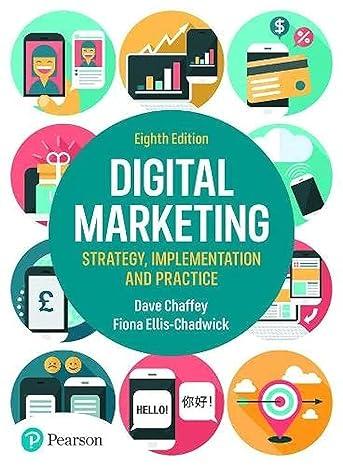This case study features a B2B service used for managing and tracking social media updates. It illustrates
Question:
This case study features a B2B service used for managing and tracking social media updates. It illustrates success factors for an agile startup business developing into a profitable mature business that adopted a datadriven mindset to drive growth. The founder believes in ‘radical transparency’ to openly share tests and insights, and this makes it a useful case study to learn from since interesting details are often not revealed in other cases.
Joel Gascoigne formed Buffer in Birmingham in the United Kingdom. The initiation of the company was data driven. From his ‘lightbulb’ moment of a service to improve social sharing and scheduling, his minimum viable product (MVP) was a landing page to assess interest in the service. Initial registrations and feedback via Twitter were sufficient for him to commit to launch the project and he personally designed and built the first version of the Buffer application for using with Twitter over seven weeks, as described by Buffer (Gascoigne, 2011). Today it supports Instagram, Facebook, Pinterest and LinkedIn also.
Buffer’s value proposition
Gascoigne describes his vision for the product like this:
I wanted to take the scheduling feature of many Twitter clients and apps and make that single feature awesome. I believed that single feature was worthy of its own application. The aim was to create something genuinely useful with a delightful experience.
The fundamental idea was to create a way to queue up tweets without scheduling each tweet individually.
After the initial landing page test was validated, a further test was run to assess how much people would be prepared to pay. A freemium revenue model was devised where there was a free service that businesses could subscribe to, with more advanced scheduling available for subscribers to paid plans. Gascoigne found that sufficient people were clicking on the details of the $5 and $10 per month plans to suggest some people were prepared to pay. Today, payment plans vary from $15 to $99 per month.
After reaching a critical mass of registrations, Gascoigne built and designed the first version of the application software during evenings and over weekends over a span of seven weeks. This again used the MVP concept to minimise features, but show a clear benefit for the paid plan. Initially, Gascoigne was bootstrapping the company by working on web development contracts at the same time.
In 2016, Buffer would extend the proposition to social media customer service by launching a ‘Reply’ feature based on an acquisition of another company. Ultimately that was not successful and in 2020 Buffer retired that feature.
Today, Buffer’s value proposition communication ( Figure 6.17) centres on the marketer’s ‘use-case’ of managing social media as part of marketing campaigns.
It offers to ‘Plan and analyse your campaigns’ by scheduling, tagging content by initiative and reviewing work in detailed reports. It also offers ‘auto-scheduling’ and recommendations on when, what and how often to post to maximise audience engagement.
Figure 6.17:

The company has also somewhat reduced the functionality of the free plan and in 2018 it highlighted some of the limitations of the freemium model, which incurs costs for supporting free users and providing the service to them. At this time, according to Buffer (2020) it had:
• 30,000 people signing up for a free Buffer account every week;
• 1,000 requests for help every week from Free users;
• 80,000 paying customers and over 300,000 active Free users.
Launch and marketing to achieve growth
On launch, Buffer found that, with the initial pricing, there was a 4 per cent conversion rate from the free plan to the paid plan. The first paying customer was achieved after four days of launch and within a few weeks users reached 100, and then increased to 100,000 users within the next nine months!
As new customers subscribed, Gascoigne resisted the temptation to simply build more features; rather he assessed the business model, including marketing and customer development. Gascoigne notes:
After the first paying customer, I took a step back, acknowledged that as a major milestone and decided a slight shift in focus was required. As a developer, it is easy to pile in more features at that point. I knew it was time to focus on marketing and further customer development. It was time to keep the balance of development, marketing and customer development with a product which had proved it was ‘good enough’.
By early 2011 the company reached what Gascoigne (2020) describes as ramen profitability, i.e. where you’re making just enough to pay your living expenses. For him, that first goal was £1,200 per month...............
Questions
1 Explain the data-driven customer acquisition and retention techniques that Buffer used to grow the company.
2 How has Buffer used social media and content marketing to grow the business?
Step by Step Answer:

Digital Marketing Strategy Implementation And Practice
ISBN: 247145
8th Edition
Authors: Dave Chaffey, Fiona Ellis Chadwick





